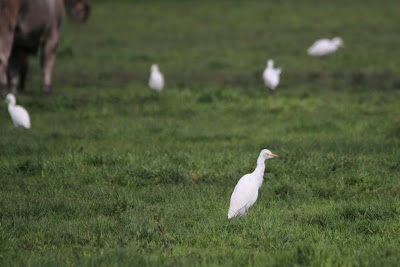The bird that has attracted my interest this week is the Cattle egret (
Ardea ibis on the Australian fauna list,
Bubulcus ibis everywhere else!). The interest arose after a highway sighting of a good sized group near Grantville in southern Victoria. I had seen them in the same spot two weeks earlier so was braced to slow from 100kmh, make use of a couple of U-turn lanes to get back to the spot for some roadside photos.
 |
| Cattle egret - today's pictures have them at the treacherous end of the cows! |
From a Victorian's perspective Cattle egret are a little novel. Their presence is somewhat seasonal appearing mostly in winter and not in the numbers seen up north. They are a relatively recent arrival in Australia (about 1950 I think I have read) and as many would be aware the global range of this species has increased dramatically over the last 100 years.
I am yet to witness breeding plumage in Victoria but I have seen others' photos of birds in Victoria with much colour.
I counted around 90 birds in this paddock which is far more than I have seen before.


























































